As the Canadian Potato Council’s latest round of research projects wraps up, those involved have deemed their projects a success.
Five years ago, Canadian potato researchers had a lot of unanswered questions. They were just embarking on a five-year research funding cycle through the Canadian Potato Council (CPC) as part of the Canadian Horticultural Council’s AgriScience Cluster for Horticulture projects funded by the Canadian Agricultural Partnership.
Eight projects covering wide swatches of the country’s potato industry were chosen to be studied. Some were continuations from previous research clusters while others were brand new endeavours. Despite challenges posed by the pandemic, researchers were able to accomplish almost all their goals.
“Many of these projects had outcomes that not only have the potential to influence decisions that growers are making on their farms across Canada, (but) some of these things are already being put into practice,” Tracy Shinners-Carnelley, chair of the CPC research working group, says in a phone interview.
For Shinners-Carnelley, she views the research as being practical for growers — information they’re able to use day to day on their farms. Lots of research is completed at upstream levels where the information may help with long-term work, but it isn’t always able to be used by growers right away.
“The whole point of these clusters is really to build that collaborative effort between the research community and the industry. And I think these projects, whether it be through wireworm, or through the scab work, have accomplished that,” she explains. “There’s many of these examples from these projects, and the development of this collaboration, where it really is delivering on the investment that potato growers from across Canada have made into cluster research.”
The cluster officially started on April 1, 2018, wrapping as of March 31, 2023. While final reports are still being compiled and information gathered for dissemination, the lead researchers on the projects sat down with Spud Smart to share their findings.
Wireworm Worries a Thing of the Past
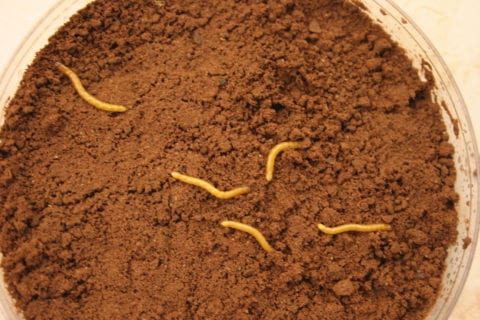
After three rounds of cluster research projects on wireworms, Agriculture and Agri-Food Canada (AAFC) Researcher Christine Noronha is deeming her team’s work a success.
Over a decade ago when Noronha first started researching the pest, there wasn’t much known about wireworms. Now growers have access to an insecticide for wireworm control, Cimegra from BASF, which Noronha’s team was involved in research trials for the registration, options for rotational crops to grow such as buckwheat, and information on the main species of wireworms in Canada.
“We can now work on having multi species pheromone traps that we could put in the field. And then usually in these fields, you have multi-species, you don’t have just one species in the field. So, it’s good to have something like this — you can just go out and put one trap instead of putting five different traps,” Noronha explains in an interview.
Noronha is now working hard to put together the final pieces to release a digital wireworm protection manual online. The manual will be a series of pre-recorded presentations growers can view focusing on various topics regarding wireworm management. She hopes to be able to release it in time for the 2024 growing season.
Stopping PED in its Tracks
Five years ago, the Canadian potato industry could only imagine having a network of researchers across the country connected and working together to track and manage potato early dying (PED). Today that is a reality with the Canadian PED Network, aka the CanPEDNet.
“I want (growers) to know their soil, know their potato early dying problem, know who’s causing it, (including the) sampling of soil and determining what species of verticillium is there and what species of nematodes is there. Because depending on who’s present, you may not have to deal with a problem,” Mario Tenuta, NSERC/WGRF/Fertilizer Canada Industrial Research chair in 4R Nutrient Stewardship and a professor of applied soil ecology at the University of Manitoba and project lead, explains in a phone interview.
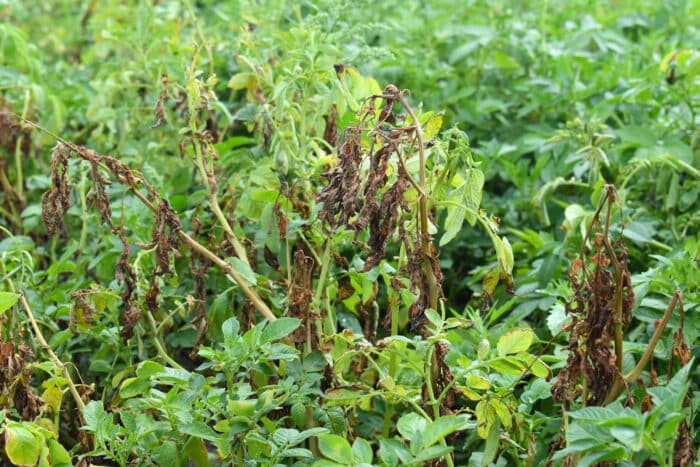
Throughout the project, Tenuta and his team were able to learn what verticillium pathogens and nematode pests were present in different regions for PED, and they were able to develop a fast soil test for verticillium dahliae, which is now being used by Agricultural Certification Services in Fredericton, N.B.
“We hit the different objectives in terms of addressing them — we’re pretty proud of that. And I think we have really good data and foundation to provide recommendations to growers on how to move forward with reducing and managing potato early dying across Canada,” Tenuta adds.
Access to the data from CanPEDNet will be made available through Tenuta’s website soilecology.ca.
Evaluating Potato Varieties for the Future
Access to new potato varieties is important for growers across the country. The variety evaluation project determined the adaptability of promising new varieties or selections in different growing conditions and locations across Canada. Varieties from AAFC’s National Potato Breeding Program and selections from private breeding programs, university breeding programs in the United States and Canada were included.
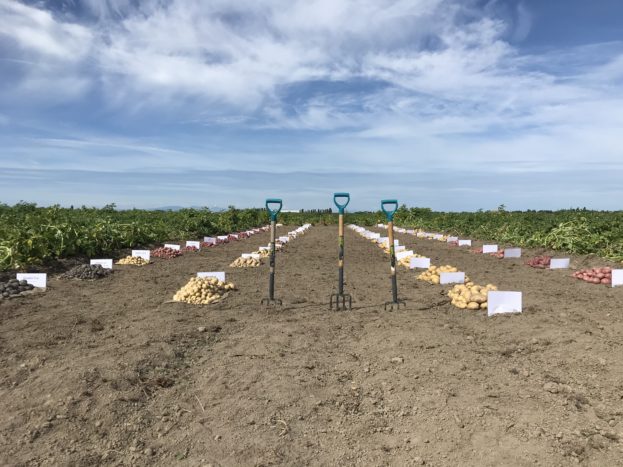
“The goal is to get Canadian varieties out there that the industry is interested in. Having the field days makes sure we have that contact and that we gain early feedback from the industry,” Erica Fava, biologist with AAFC, explains in a phone interview. “(Grower) feedback on our selections is really important to us, so that we can modify the way we do things to make sure that they’re getting the varieties with the traits they want and that they need.”
The pandemic held the project team back from being able to hold field days every year, which reduced the opportunities for growers to view the new varieties. But over the five years of project, the project led to having 24 licenses issued for new potato varieties for Canadian growers.
Leaving Late Blight in the Rear View
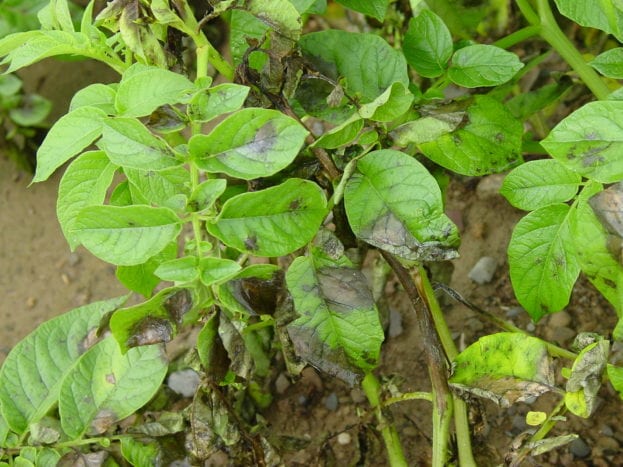
Late blight isn’t just a disease that affects potatoes, but also tomatoes. This is why it has been important for researchers working on the disease to study it and make sure those growing tomatoes include home gardeners, who are aware of it.
“That connection with potatoes and tomatoes we found still to be important. Typically, (the) US23 (strain) tends to be more virulent on tomato than potato but certainly very virulent on potato tubers,” Rick Peters, research scientist at Charlottetown Research and Development Centre, says in a phone interview. “Because of that, we’ve been really trying to encourage home gardeners to grow late blight resistant varieties.”
US23 remains the most prevalent late blight strain outside of British Columbia. However, in B.C. strains of both A and A2 mating types and some showing resistance to Ridomil were found. Peters’ team is still looking closer into the strain diversity in B.C. The researchers also found that some of the newer strains seem to be adapting to warmer conditions, whereas previous strains have favoured wet weather with periods of cooler temperatures.
“We were still able to accomplish most of the goals based on the samples we did get every year and found some new things that I think will be helpful,” Peters adds. Due to non-conducive weather for late blight, they were unable to collect samples from Alberta, Manitoba, or the Maritimes, during those five years.
Tracking Colorado Potato Beetles Down
While researchers were able to learn more about Colorado potato beetles (CPBs) during their research project, not every goal was accomplished. With access to labs reduced during the pandemic, some parts of the project were delayed, meaning not all objectives were met.
“We lost a lot of time required to access both insecticide resistance in the beetle populations, and identifying molecular targets that could be used as markers of resistance,” Chandra Moffat, research scientist and entomologist with AAFC Summerland, explains in a Zoom interview. “We were still able to generate substantial new knowledge on regional patterns of insecticide by evaluating nearly 140 populations collected over five years from five regions of Canada. But in terms of trying to take that to the next level, to develop a screening tool for producers, this would take a few more years to accomplish.”
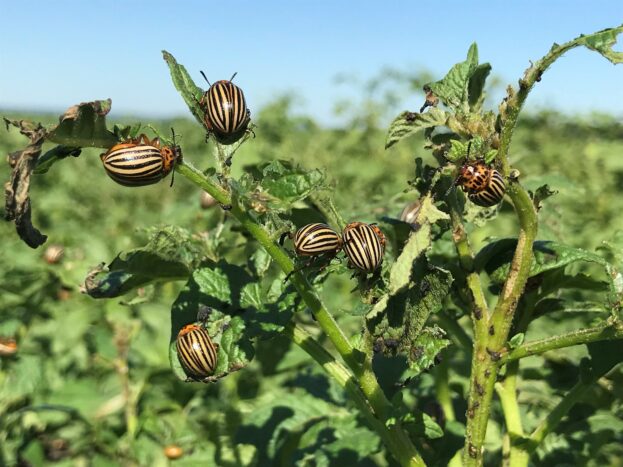
The plan had been to develop a bioassay that labs could use based on molecular differences to screen CPBs for resistance, allowing for faster results than current methods allow.
The researchers are still working on developing a web-based application which will show CPB resistance populations in real time. It’s currently in the final stages of development with AAFC’s agri-geomatics team.
Reducing Common Scab Concerns in Canada
The first national common scab research project has been deemed a success with researchers able to identify genetic groups across the country and then investigate control methods.
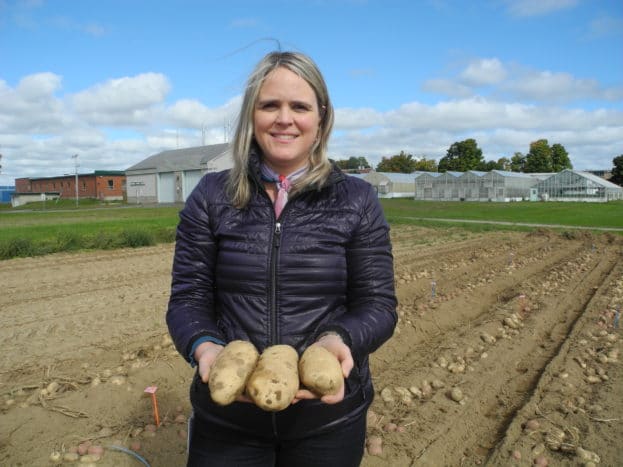
They looked “at the genetic groups of the different the pathogens causing common scab in different areas of Canada, showing that there was a large variability in their genetics. Molecular tools were developed to follow specific genetic groups in the fields, which has not been done before, very intensively,” Claudia Goyer, a research scientist at AAFC’s Fredericton Research and Development Centre, explains in a phone interview. “The lesser virulent genetic group were more abundant compared to the very virulent one. But the virulent one, the abundance of the population in the fields were going up over the summers.”
The team was able to identify two control methods that showed promising results — the biopesticide Serenade Soil and auxin product 2,4-D. Field tests in Manitoba and New Brunswick showed Serenade Soil reduced common scab severity. In Manitoba trials 2,4-D was effective for common scab control, however, some genotypes don’t respond to 2,4-D. Currently 2,4-D is only registered for use on red potato varieties in Canada, but there are plans to expand its label uses in the future.
Pinpointing Necrotic Viruses in Canada
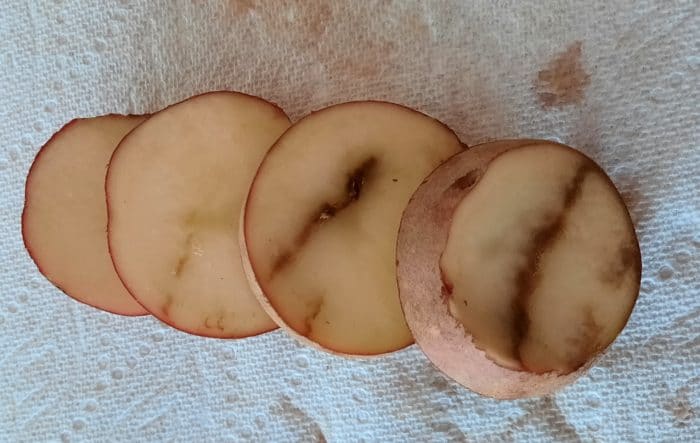
Some of the mysteries around necrotic viruses in Canada have been solved following a research project looking into them. While there are wide range of necrotic viruses this project focused on, the four different ones known to be in Canada are potato virus Y (PVY), alfalfa mosaic virus (AMV), tobacco rattle virus (TRV) and potato mop-top virus (PMTV).
The project had three major objectives — to identify what necrotic viruses are in Canada, to develop an accurate way to detect PMTV in soil and investigate variety responses to necrotic viruses. All objectives were accomplished, but the major achievement was the development of the PMTV soil test.
Xianzhou Nie, a research scientist at AAFC Fredericton Research and Development Centre, and his team were able to develop a procedure called high resolution DNA melting (HRM) assay for detection of both PMTV and its protist vector, Spongospora subterranea f. sp. subterranea (Sss), from soil directly. When the test was used on soil samples from fields across New Brunswick where PMTV or Sss infected tubers had been found, PMTV or Sss was found in 63 to 100 per cent of samples. Samples from fields with no infected tubers, were found to have no PMTV or Sss discovered.
Previous tests had required the bait plant to be tested for PMTV infection, with Nie’s teams’ finding the soil in a suspected infected field can be tested now instead, making for a faster diagnosis.
Using Precision Ag to Farm Smarter
There’s a lot more to your fields than what you see on the surface. As part of the smart farming project, researchers used precision agriculture to map field management zones. Through the project growers were able to expand on previous yield monitoring they had been using. Field management zones were mapped to tell growers a wealth of information.
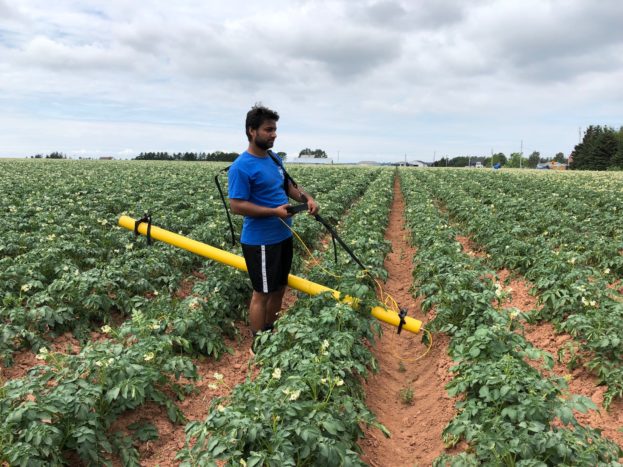
Growers “have valuable data and they have to value (that data). They (have used) yield monitoring for many years. And most of them only look at us and say ‘Yeah, there is more yield, less yield there,’— (there) is already (value there) but there is much more to do with those yield maps,” Athyna Cambouris, precision agriculture scientist at AAFC, says in a Microsoft Teams interview.
Through mapping these management zones using technology such as ground conductivity sensors and yield monitors growers were able to learn about nutrient levels in their soil, water retention and other soil issues, which they then used to develop ways to improve those management zones.
Header photo — Adult Colorado potato beetles feeding on a potato plant. Photo: Tracy Shinners-Carnelley, Peak of the Market








